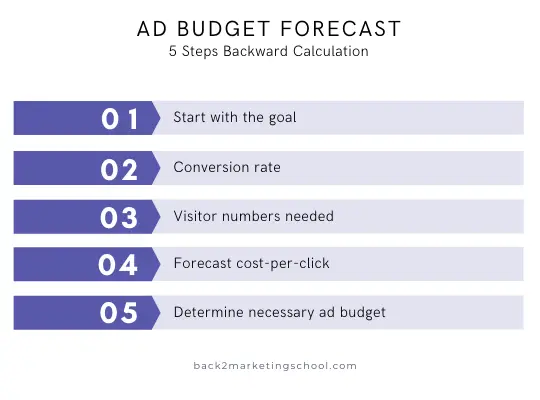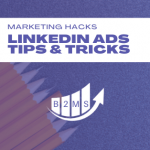Calculate your ad budget correctly
As a marketing consultant, I have to manage clients’ target expectations and budget planning for advertising campaigns all the time. Mostly, new businesses have a fundamental knowledge gap and false expectations. For example, a percentage method is completely out of context but is thrown around all the time.
(Skip to 5 steps to the right advertising budget calculation).
The most common advertising budgeting mistakes
I see the following mistakes over and over again and hope you won’t make them in the future:
- Percentage method (percentage of profit or revenue)
- No quantitative goal setting
- No needs analysis
- No data analysis
- Wrong choice of advertising channels
- Short test period & low budgets
- Unrealistic expectations
Advertising budgeting based on the percentage of sales or profit is not effective. Point. There is of course a correlation between marketing budget and sales or profit, however, this is not the right approach to how high my budget should be. It is more of a guideline of how much money is available.
In order to plan a budget properly, it first is necessary to understand what is needed. Why should advertising campaigns be launched in the first place? You need to conduct a needs analysis of how many customers or leads you need to generate in order to reach your business objectives. Closely related to this is quantitative goal setting.
The quantitative objective defines how much revenue I want to generate, how many customers I need for this, and how many leads I need to convert for this.
Of course, this projection is only possible if I know my data. What is the average revenue per customer, and what is my conversion rate from lead to a customer? How long is my sales cycle?
In addition, this often leads to the selection of the wrong advertising channels. For example, Facebook Ads in B2B are not ideal for every solution. Tik Tok is certainly a trend, but not for every target group. This often leads to short-term considerations: Social media advertising can be cheaper than LinkedIn Ads on a CPC basis, but more expensive in the long run on a cost-per-lead basis due to higher lead quality because of better-suited targeting capabilities. Additionally, adding more channels to the mix might spread your ad budget too thin.
Often (also based on the previous mistake) an arbitrary test budget is set and a too-short test period of 30 or 60 days is implemented. In paid media, you also need to spend some time, collecting data and optimizing before making a decision for or against a campaign.
Last, I always have to manage expectations. Clicks do not equate to new customer acquisition. Here is an example calculation of a Google Ads campaign:
- Ad spend: $400/month
- Average CPC: $2
- Clicks per month: 200 clicks
- Landing page conversion rate: 1%.
- Number of leads: 2
- Now the advertiser wonders why no customers were generated.
Backward calculation for optimal ad budget planning
In order to set a budget effectively, I reverse engineer the process and start with the goal and work my way through all steps in the process to define the budget that is needed to achieve that marketing goal.
How to plan an advertising budget correctly: 5 steps to the optimal advertising budget

1) Start with the goal
How many customers do I want to close my revenue gap or leads do I want to generate? “As many as possible” is unfortunately not an answer that is helpful in budget planning.
Example: 20 leads
2) Conversion rate
From here, we consider the conversion rate. We first assume that visitors are directed to a gated landing page and fill out a form or provide otherwise their contact information.
A good conversion rate is between 1% and 2%. Of course, the more relevant and better the offer, the higher this rate will be.
Please note, if we have potential customer acquisition as a target, we need to take an extra step and calculate the conversion and also the time period from lead to customer.
3) Visitor numbers
With the conversion rate, we can now calculate how many visitors we need to generate the targeted number of leads.
We can also make several assumptions: 0.5%, 1%, 1.5%, 2%, etc.
Number of visitors needed = number of planned leads / conversion rate
Example: 2000 visitors = 20 leads / 1%.
4) Forecast cost-per-click
We can now obtain a forecast of CPCs or CPX prices for each platform we want to use. It is recommended to use the forecasting tools of each advertising channel with the actual target audiences. Otherwise, it is just an assumption. Of course, historical data can be used, but advertising costs change seasonally and have generally increased sharply.
If advertising is based on eCPM or other CPX prices, you need to convert the cost into cost per visitor.
Example: $2 CPC
5) Determine the necessary advertising budget
Multiply the necessary number of visitors with the expected cost-per-clicks to calculate the advertising budget.
Advertising budget = number of necessary visitors x CPC
Example: $4,000 = 2000 visitors x $2.
Now you have your optimal budget for a successful campaign.
To save you the work, we have created a budget calculator. So you can easily and quickly experiment with numbers and develop best, base, or worst-case scenarios with ease. More, you can even forecast your Return-on-Marketing-Investment.

Sascha is a Lifecycle Marketing Consultant with over 8 years of digital marketing experiences in Silicon Valley, the UK, and Germany.
After leading the demand generation for a 100+ million company, he decided to venture out on himself. He’s now helping clients to attract and convert more leads and customers.
His main focus are SEO, paid media & marketing automation – all with the focus to tie marketing campaigns to revenue.
Sascha has been featured in industry publications.



